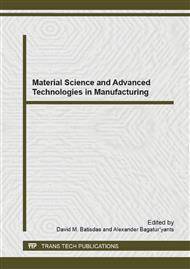p.501
p.506
p.511
p.515
p.523
p.529
p.533
p.538
p.543
Finite Element Simulation and Experimental Research in Insulation Spacer Blanking
Abstract:
Blanking finite element analysis model of non-metallic material PET insulation spacer was established, and the influence of process parameters on blanking quality of insulation spacer was analyzed. The results show that the qualified cross-section quality, the high dimensional accuracy and the little bending distortion of blanking workpiece can be obtained by the reasonable blanking clearance and the higher blanking speed. The corresponding experiment was carried out, the results show that the process parameters of insulation spacer blanking obtained by numerical simulation are feasible, and the qualified insulation spacer was produced by the simulation results.
Info:
Periodical:
Pages:
523-528
Citation:
Online since:
January 2014
Authors:
Price:
Сopyright:
© 2014 Trans Tech Publications Ltd. All Rights Reserved
Share:
Citation:


